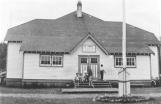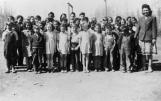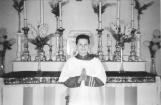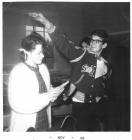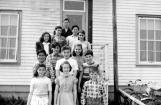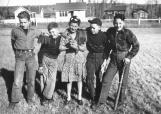

Heritage Park
Fort McMurray, Alberta
1
Welcome to St. John's Roman Catholic School!St. John's Roman Catholic School was the first separate school in Fort McMurray. This school provided education which was often of a higher quality than the public schools', thanks to the work of the Grey Nuns of Montreal. From its opening in 1936 until its closure in the 1990s, St. John's school shaped the childhoods of many of the community's residents.
3
Establishing the School DistrictBishop Gabriel Breynat and Bishop Paul Piché were influential in establishing St. John's Separate School. Both men had a passion for opening Catholic schools throughout northern Canada. Bishop Piché said of the initiative, "Parents have the obligation to guide the moral development of their children and they have the right to expect that the moral and religious principals which they teach at home will be held before the children in school. The Universal Declaration of Human Rights declares that 'Parents have prior right to choose the kind of education that shall be given to their children and are entitled to protection by society and the state.' It is a fundamental principle that the greatest importance be attached by the state to the wishes and views of the parents of the students."
When Bishop Breynat promised Fort McMurray's citizens that he would work toward bringing in a Sisters' Hospital, he did so on one condition: the Catholic community in Fort McMurray must establish a separate school board and open a Catholic school.
Frank O'Coffey wrote to Bishop Breynat in Edmonton on 18 October 1934. The purpose of his letter was to discuss creating a separate school district in Fort McMurray. In further letters, O'Coffey suggested that creating this district would be affordable. Bishop Breynat responded favourably. On 28 September 1935, 31 interested ratepayers gathered in McVittie Hall to vote on the creation of a separate school district. With votes 29 for the new school district and 2 against, the Catholic ratepayers agreed on forming the new separate school district. Frank O'Coffey, James O'Hara, and Lina McDonald made up the first Board of Trustees, while Father Chouinard OMI served as Secretary-Treasurer.
The province's Department of Education ordered the establishment of St. John's Roman Catholic Separate School District No. 32 on 8 October 1935, but it was not until the following year that construction could begin.
5
Opening the SchoolIn August of the 1936, building began. The District would have started sooner, but they were delayed by legal difficulties: the Crown owned four acres of the land on which the school was to be built. After much negotiation and fundraising, the District purchased that property for $100, or $25 per acre.
Because of the delays, the construction was not completed by September, so for the first two weeks, St. John's School's 43 students had to use St. John's Catholic Church as a classroom. Mary Redmond's Junior students sat on the kneelers and used the benches as their desks while Wilfred Louiselle taught his Senior students in the choir loft.
On 26 September 1936, the St. John's School building was ready, and class moved into the school. It was a two-room building, and had very few supplies. Mr. Louiselle, the Principal and Senior Teacher, fell ill in November and left Fort McMurray in December. Mr. Duchak replaced him as Principal and Senior Teacher in January 1937. The Junior Teacher taught grades one to four, while the Senior Teacher taught grades five to eleven.
The enrollment of the first academic year (1936-1937) was as follows: Rosie Auger, Archie Goodwin, Wilfred Laboucane, Sarah Newsam, Myrtle Pacquette, Josephine Short, Bella Auger, Margaret Desrosier, John Hainault, Antoniette Martin, Evelyn O'Hara, Arthur McDonald, Jella Newsam, Harry O'Hara, Henry Townan, Gilbert McDougal, Martha Auger, Lawrence Laboucane, Angus Larocque, Elsie Hainault, George Auger, Marian Castor, Lena Castor, Rollo Goodwin, Irene Hainault, Fred McDonald, Elizabeth Powder, Julia Powder, Christine McDonald, Lina Shott, Yvonne Valcourt, Lawrence Auger, William Castor, Johnny Ducharme, Leo Dusseault, Marcel Dusseault, Louise Fontaine, George Griguiser, Victor Griguiser, Florence Laboucane, Margaret McDonald, Mary Jean McDonald, and Germaine Somers.
6
Mary Redmond, the First Junior TeacherMary Redmond was the first Junior Teacher at St. John's. She had taught for three and a half years at Tiviere Qui Barre before heading to Fort McMurray in 1936. She remembers that on the last stage of the journey, at Cooking Lake, she got into a float plane with the famous First World War flier and bush pilot "Wop" May, and with Con Farrell, another renowned pilot. After a three hour flight they landed on the Snye in Fort McMurray.
Redmond taught grades one to four, consisting of 30 pupils that first year. Supplies were scarce. She remembers using a piece of chalk until it was so short that her fingers scraped the board. For Christmas 1936, Mary took her first trip out of Fort McMurray into Edmonton, where she visited Woolsworth. There she bought school supplies, including pictures for the wall. However, she did not buy a wastebasket, so they used an apple box that she covered with pictures cut out from an Eaton's Catalogue.
Redmond once went walking with a friend in the winter, and when they got to MacDonald Island they built a campfire. Redmond managed to soak one of her mukluks. Her foot froze and was frostbitten. For weeks after that her students retrieved her from her home using a dog sled, and then took her home after class. She moved to Edmonton in 1940.
7
Grade 8 class picture at St. John's Roman Catholic School1947
St. John's Roman Catholic School, Fort McMurray, Alberta, Canada
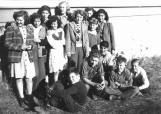 Credits:
Credits:School Reunion
Fort McMurray Historical Society
8
Early DevelopmentsIn the 1937-1938 school year, St. John's added grade eleven to its curriculum, accepting three students into this grade. The following year, they added a grade twelve program, in which two students enrolled. By the academic year beginning in 1939, three students were studying in grade twelve. At this time Peter Pond School, Fort McMurray's public school, did not offer higher than grade ten.
In June 1940, both Duchak and Redmond left Fort McMurray. Duchak joined the Air Force and Redmond left to teach in Edmonton. St. John's cancelled its grade eleven and twelve programs at the same time because those students who would have enrolled in these classes had enlisted or were filling in the employment gaps left by those who had. It was not until the Second World War ended that St. John's added these grades back into the curriculum.
Due to financial difficulties, the District could not afford to give high wages. In addition to this, living and working conditions in Fort McMurray were lower than most Canadians expected. These factors made it difficult for the District to hire male teachers, especially ones with families to support. As such they tended to rely on young, single female teachers. Even then they had difficulty finding anyone willing to risk the move to northern Alberta. Struggling to find staff, the District turned to a resource they felt they could rely on: the Grey Nuns of Montreal.
10
Financial PerilWhen the ratepayers decided to establish a separate school, the financial situation looked promising. Within a few years of the school's opening, however, population changes jeopardized the District's survival and put stress on all of the school districts in the area.
In the late 1930s, Fort McMurray as we know it today was still divided into several separate communities, particularly Fort McMurray and Waterways. Most of the ratepayers lived in Waterways, so when a new public School District opened in Waterways in the fall of 1938, many of them switched to the new district. While it was not a Catholic school, it was closer. St. John's Separate School Board still had debt outstanding from the land purchase and the building construction, and now there were fewer ratepayers to cover that debt. In December 1939, yet another public district opened in Abasand, resulting in even fewer ratepayers.
In January 1940, 57 students were enrolled in St. John's. The District's assets totaled $8,844.35, while its debts totaled $9,378.92 and its annual operation costs sat at $2,200.00. Because the public district was also struggling financially due to the split population, some citizens began encouraging consolidation. Father Chouinard OMI was hesitant about merging the districts, however, because he believed it was important to include religious education in schools. Bishop Breynat OMI petitioned for, and received, funds from the Catholic Church Extension Society in Toronto. These funds, combined with donations from local people and businesses like the Ryan Brothers, covered the debts and allowed the school to remain open.
Even after this initial crisis was averted, the District was repeatedly challenged by a growing population and the resultant housing shortages. St. John's Roman Catholic School Board struggled to cover debts and additional costs until 1979, when Bill 76 granted Catholic school funding per pupil at a rate equal to the public schools.
11
Grey Nun, likely Sister Evelyne Gagnon, with children1934-1945
St. John's Roman Catholic School, Fort McMurray, Alberta, Canada
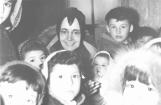 Credits:
Credits:School Reunion
Fort McMurray Historical Society
12
The Grey Nuns ArriveIn 1947, the School Board discussed getting a Community of Sisters to teach St. John's students and they discussed building a residence for them. Father Lesage wrote to the Mother Superior of the Grey Nuns of Montreal in 1948, requesting that they take over the teaching of St. John's Roman Catholic School. After deliberation and prayer, the Grey Nuns of Montreal accepted and in August 1949 they sent Sister Marie Boulet and Mother Courville. Sister Boulet at that time had 28 years of experience teaching in western Canada. They also promised to send Miss Antoinette Aquin as an assistant before school began. While the school continued to employ some lay people as teachers--in particular, single women--the Grey Nuns took on much of the teaching themselves and also formed the school's administration. They received $100 per month in wages, but returned that money directly to the Board for hiring lay teachers. In essence, the nuns worked for free.
The Grey Nuns would depart in 1971, but other orders of nuns served in the Fort McMurray Catholic schools in the years following the Grey Nuns' departure. Nuns from the Sisters of the Holy Cross, the Sisters of Service, and the Sisters of St. Martha all taught in Fort McMurray Catholic schools.
13
Four nuns and two children near St. John's Roman Catholic Schoolcirca 1960
Fort McMurray, Alberta, Canada
 Credits:
Credits:School Reunion
Fort McMurray Historical Society
14
Growth and AdditionsAt the end of the 1940s, the Board realized they needed to upgrade St. John's from a two-room schoolhouse to something larger. When construction began on the new St. John's Church in 1949, the lay brothers, under Brother Bruyère, also added two new rooms to St. John's school. This addition cost $11,314.00. Bishop Trocellier lent $5,908.00 to the Board to help ease the financial pressure. The Board also purchased a used 34-passenger bus, which James Hutchinson drove.
In 1949, Father Lesage succeeded in establishing St. Peter's Roman Catholic School District in Waterways. This meant that the Catholic students in Waterways no longer attended the Waterways school. Instead they attended St. John's school, beginning in September 1950. Unsure of how many children would arrive from Waterways, the Board decided that three teachers--Sister Boulet, Miss Carmen Turcotte, and Miss Therese Desrosiers--would have to suffice. When 107 students arrived, the Board began looking for another teacher, and Miss Blache Regimbalde arrived in October.
Due to the influx of students, the Board yet again discussed adding another classroom. Brother Bruyère had left room on the second floor. The Board, however, had to ask for approval from the Provincial Department of Education before they could use the second floor. The Department denied approval, but St. John's used it as a classroom in 1951 anyway because enrollment was still high. That year, there were five teachers: Sister Marie Boulet, Miss Laurette Marquis, Miss Germaine Somers, Miss Therese Desrosiers, and Miss Loretta Scarbar.
By the end of the 1954-1955 academic year, enrolment had increased by so much that yet another addition was necessary. Now grade eleven and twelve students from the public school system were taking classes at St. John's because the public schools still did not offer these grades. Despite the Protestant-Catholic tensions, some non-Catholic families decided to send their students to St. John's instead of going to Edmonton for the upper grades. Enrolment spiked again. In March 1956, the new Principal, Sister Yvette Lapointe, received approval from the Provincial Department of Education to build a new addition. The new section included three classrooms, an audio-visual room, and a gymnasium. Rain delayed the project past the beginning of the school year in September. On the first day, more than 200 students enrolled, managed by six teachers (Sister Yvette Lapointe, Wally Walcer, Sister Pouliot, Miss Jeanna Durieux, Mrs. Gisele Golosky, and Miss Noella Sequin). The extension was not fit for use until September 1957, during which 224 students were enrolled.
One reason for such growth was the increase in Fort McMurray's population. Another possible factor was that the Grey Nuns had a reputation for higher quality teaching than the public school's teachers. Some families switched schools not because they were Catholic or because their children were entering grade eleven, but because they heard that St. John's was simply a better school.
15
Classroom with teenaged students and Grey NunMay 1953
St. John's Roman Catholic School, Fort McMurray, Alberta, Canada
 Credits:
Credits:School Reunion
Fort McMurray Historical Society
16
Growth and Additions continued272 students were enrolled at St. John's by the end of the '63-'64 academic year, and the Board was confident that the growth would continue. They hired Lonergan Co. to extend and renovate the school, adding classrooms, a library, an infirmary, and a staff room. By 30 September 1964, enrolment was 283.
Anticipating even higher student numbers in the next few years, the Board decided in 1965 that they would need to build a new school. Not only was Fort McMurray's population still increasing at a significant rate, but St. John's original structure and the additions built in the 1940s were condemned and destroyed in 1967 due to their advanced age and deteriorating condition. All that was left of St. John's was the newer additions. More students in fewer classrooms would not work, so in 1968 construction began on a new elementary school. It was named after Father Turcotte. In the winter of 1969, J. A. Turcotte O.M.I. Elementary School opened at last. It held grades one through five. Grades six and up remained in St. John's, which changed its name to St. John's High School.
In the 70s, St. John's High School became St. John's Junior High School. Grades 10 and 11 moved into Peter Pond High School, which was part of the public system. In 1974, enrolment was still growing. The school had to convert the gymnasium into an industrial arts classroom. The Phys Ed teacher was not discouraged; he held his classes in the hallway outside the Principal's office.
In 1983, the Board decided to modernize the school. The project cost almost $2 million and took until the summer of 1984 to complete. While school was in session during construction, Principal McIsaac instituted a rotational program: students had class in one section of the building in the morning while the workers worked on another section, and then after lunch they would switch.
After the modernization, St. John's saw a standstill and then a decrease in enrolment. Fort McMurray's population was shifting from the downtown section, where St. John's was located, into the newer communities of Thickwood Heights and Timberlea. Many students from Gregoire, Beaconhill, Abasand Heights, and Waterways still attended St. John's, but the total enrolment declined nonetheless. For instance, in 1982 the school had 560 students, while in 1986 there were 350 students enrolled.
17
Father Turcotte and Sister Lapointe with students in classroom1950-1959
St. John's Roman Catholic School, Fort McMurray, Alberta, Canada
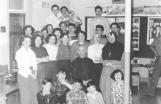 Credits:
Credits:School Reunion
Fort McMurray Historical Society
18
ClassesAs society changes, so do the classes schools offer. The Catholic schools of Fort McMurray were no exception. How St. John's students and staff dealt with their culture's changes helped define who they were.
In the 70s, the school attempted to diversify its physical education program, introducing calisthenics, tumbling, trampoline, javelin, discus, and shotpot. Square dancing made its way into the grade 9 program. After squaring dancing's unexpected success there, grades 8 and 7 adopted the activity. Students remember enjoying it and finding it more exhausting than a game of hockey. In 1978 the school changed its focus in physical education to participation, making the class accessible to students of all levels of athletic ability.
The advent of the commercial computer in the 80s demanded that schools add new courses to their curriculums. In 1982, St. John's offered computer literacy courses and in 1984 the Board began constructing standardized programs for this subject.
While St. John's offered a number of courses and opportunities in the arts, these were all optional and specialized. Music was divided between choral and instrumental, art was optional, and drama and dance were separate programs not incorporated into classes.
Religious education courses define the Catholic school system. Unlike public schools, a Catholic school has mandatory classes in the fundamentals of Catholic practice, theology, and morality. St. John's used the Edmonton Christian Living Series for its junior high students. This program was designed to assist students in recognizing the presence of God in their present life experience. The community held certain Catholic celebrations and masses in the school to help in the students' Catholic education. During Lent, members of the Catholic community joined classes in the morning to lead in prayer and readings. Younger students prepared for their first communion and older students prepared for their Confirmation, a ceremony over which the local bishop often presided.
19
Lola Isert and Margaret Mercier, teachers, standing outside of St. John's Roman Catholic School1940-1945
St. John's Roman Catholic School, Fort McMurray, Alberta, Canada
 Credits:
Credits:Doris Somers
Fort McMurray Historical Society
20
Life at SchoolAs the years passed, conditions in St. John's Roman Catholic School changed. Class sizes grew and shrank, technology emerged, rules changed, and customs evolved. This development is hard to track, but the memories of those who studied at St. John's give some insights on life in Fort McMurray's first Catholic school.
Mary Redmond offers a look into the school's first years. She recalls that the lay brothers from the mission had difficulty keeping the furnace going. The school was cold so often that she regularly wore mukluks and ski pants in class.
Merle Rudiak, formerly Golosky, recalls attending St. John's School in the late 1940s and early 1950s. The nuns had built a huge log slide in the winter, with two big store cases on each side, and between these cases were six slides. They put snow on the slides and then watered it to make them icy. Sister Sutherland would slide with the children, her cap flying out behind her. Once, the students piled snow at the bottom of the slide. Sister Sutherland came down and went straight into the snow. "She was all wet!" Rudiak recalls.
There were dances on Friday nights. Someone would play the piano while the students danced. Sister Boulet would lift her skirts and tap her toes. Sister Lapoint eventually replaced Sister Boulet as principal and produced the Christmas, Spring, and Easter concerts. Rudiak remembers that the nuns' hands would be red or yellow or blue depending on what costumes they were making at the time. The nuns often made costumes from scratch, dyeing their own material. The weeks before a production involved not only practicing on the students' part but also sewing and fitting on the nuns' part. The costumes always fit well and were quite ornate.
The Grey Nuns helped students who stayed at school for lunch, Rudiak recalls. They made soup and cocoa in the Hospital attic. From there the students carried it to the school's attic, which they used as a lunchroom. The older students were responsible for ensuring the younger students had enough to eat.
When Jean Golosky taught forty-four students in her grade three-four split class in the late 1950s, her students ranged from ages 7 through 14. Some of the older students only went to school for a single month in the fall and a single month in the spring, spending the rest of the school year on the trapline. It took them a long time to complete a grade this way.
Golosky also remembers that there were no substitute teachers, so if a teacher was ill or stranded in Edmonton, their class was cancelled and the students returned home.
Joanne Auger studied at St. John's in the 1960s. She recalls that smoking was not allowed at school, so the students would go outside the fence and smoke. There were no uniforms, but there was a dress code--girls had to wear dresses, not shorts or pants. During the winter they could wear long pants to and from school, but at school they had to wear a dress.
In the 1973-1974 academic year, St. John's decided to adopt the new Open Forum teaching concept. In this program there were three classes of up to 100 students. One teacher taught each class, with two teachers supporting. After the initial excitement, the teachers discovered that the program was not working. Frank McDonagh recalls of the experiment: "We realized it was disastrous trying to function with 100 students between the ages of 14 and 15!" Before the year was out, St. John's had switched back to more familiar class sizes.
21
Grey Nun standing with students near slide1950-1965
St. John's Roman Catholic School, Fort McMurray, Alberta, Canada
 Credits:
Credits:School Reunion
Fort McMurray Historical Society
22
Teacher ShortagesEven though enrolment had levelled out in the early 1950s, it was still a challenge to keep an efficient student-teacher ratio because teachers tended to leave. Not all of the teachers who remained were considered suitable, either. Father Lesage wrote to the Superintendent of Education in Fort Smith, NWT, "The Principal, Sr. I. Gallant has been transferred to Hay River. Earlier, Sr. Champourx had been transferred to Chipewyan. After the school opening we managed to get two non-Catholic teachers. One of them has now been instructed to discontinue teaching forthwith, because of lack of proper qualifications. The other is a Hindu (no disrespect intended) who has much difficulty to discipline the class. A third one is an addict to alcohol. Thus, the whole school is affected by the adverse influence of those teachers.
"It will take a teacher of strong character to assume the function of teaching in Grades 6 and 7 which have gone 'wild'."
The Board built teacherages and petitioned to the Grey Nuns for more staff, but even these efforts only managed to secure the minimum teachers required. The teacher and space shortage had some unusual results. For instance, Sister Lapointe taught chemistry in the evenings so that students could get their matriculation requirements.
23
Sam Morie, teacher at St. John's Roman Catholic School1948
 Credits:
Credits:Doris Somers
Fort McMurray Historical Society
24
Catholic Schools from the 1960s to the 1980sJ. A. Turcotte O.M.I. Elementary School opened in January 1969, the second Catholic school in the area. Taking the younger students from St. John's Roman Catholic School, Turcotte Elementary helped ease the burden on the overpopulated schools. It opened with 14 full-time teachers and 300 students. During its first years, Principal Frank Peters was busy transforming the school's storage closets into classrooms or offices for new staff members, such as the guidance counsellor.
Good Shepherd Elementary School was named by eight-year old Bridget Churchill, who said that as the Good Shepherd cares for his flock, a Good Shepherd School would care for its children. The school was slated for opening in 1975, but the building was not ready in time. It was not until November that the school was ready for use.
St. Paul's Elementary School was also built in 1975, and like Good Shepherd was not ready by September. Both schools housed students in Turcotte Elementary until they were finished.
Composite High School, a joint venture between the Catholic and Public school boards, opened in January 1977. About one in three students were Catholic. The Boards decided to follow through with this project instead of each building their own smaller high school with limited resources. Composite was known for its trades program. In 1982, however, the Catholic Board backed out of the Composite venture due to its desire to include religious education at the high school level.
Students from Abasand registered in Father M. Beauregard OMI Educational Community Centre, named after Father Maurice Beauregard, for the beginning of the 1978-79 school year. However, as with many building projects in Fort McMurray, the school was not completed by September. The school, known colloquially as the Father Beauregard Edu-Com Centre, was not finished until the New Year. It opened its door on 20 February 1979 to 160 students. This school made an effort to integrate the community into its activities, using its spaces for community group meetings, fitness and Tai Chi classes, and a hospital overflow or emergency holding area.
St. Gabriel's Elementary School was built in response to the growing body of students in the Thickwood Heights area. The school opened on time in September 1981. It received 287 students on the first day, from kindergarten through grade seven. This was 32 students more than anticipated, meaning that on the first day St. Gabriel's was two classrooms over capacity. Due to rapid growth in the Thickwood area, the school continued to receive higher enrolments and had to bring in many portable classrooms.
Father Mercredi Community High School was opened as a way of including Catholic education into the high school curriculum. It opened in September 1982, receiving 700 students. The school's namesake, Father Patrick Mercredi, died one day before the school's official opening on 1 November 1982. One interesting policy at Father Mercredi was the absence of bells. Class length was regulated and maintained by the teachers rather than by a public audio system. This policy was planned to help teachers and students feel less like part of an institution or bureaucracy.
St. Anne's School opened on 3 September 1983 to accommodate the new Timberlea population. It managed to open on time, despite a number of last-minute requirements. Like any other school in an area with a blooming population, St. Anne's struggled to adjust to its growing student body.
25
Father Patrick Mercredi and Father Sylvio Lesage, soccer goalposts in background1940-1948
Fort McMurray, Alberta, Canada
 Credits:
Credits:Doris Somers
Fort McMurray Historical Society
26
Students RememberMyrtle Pacquette started attending St. John's when it opened. At that time she was in grade five and was living in the Old Catholic Mission. Mr. Loiselle was her first teacher, but she remembers that he did not stay long. His replacement was Mr. Duchak. Myrtle would walk to school, even on winter days that were 50 degrees below zero. The room was so cold, she remembers, that the students would go into the basement to hug the furnace to warm up. Sometimes they held class next to the furnace until the room upstairs was warm enough. June was better: not only was it warmer, but there was the annual track meet between the students of St. John's and Peter Pond. This was a very competitive event, and they would train hard each year. Myrtle graduated from grade eight when she was fifteen years old.
Phil Pacquette, one of Myrtle Pacquette's nephews, started at St. John's in 1944 and left in grade nine. He remembers Father Mercredi fondly: "He played basketball, hockey, and baseball with us. Father also coached both our school baseball team and hockey team. We were great rivals with the Peter Pond Public School." He was impressed with the Grey Nuns' dedication and teaching skills. He remembers Sister Lapointe for trying to talk him into staying in school.
Roy Hawkins switched from the public school system to St. John's for his grade eleven year. At that time he had only two classmates, brothers Pat and Lowry O'Coffey. He recounts that St. John's opening was for some students a "traumatic experience," especially in athletics, because students who originally trained together and played together now competed on opposite teams. Despite the split in sports, he remembers that the two schools collaborated on the Christmas concert. They alternated which school hosted the concert from year to year. Later in life, Roy Hawkins had three children--Patrick, Beverley, and Richard--all of whom also attended St. John's School.
Patrick Hawkins graduated from St. John's in 1964, while his sister Beverley graduated in 1966. Their brother Richard started at St. John's in 1950, when he was six years old. His first teacher was Giselle Golosky and his second teacher was Miss Marcotte. In Richard's opinion, teachers were more than just teachers: "They'd spend eight hours a day at school. Then afterwards they would spend time with us, coaching and training us in sports." His First Communion in March 1951 was what he called an "elaborate affair." The students sported a dark suit or a white dress, and an arm band. The girls sat on one side of the church and the boys sat on the other. After communion, they paired off down the aisle and headed to the Grey Nuns' for a large banquet. Richard became an altar boy and recalls that his classmate Ron Henriette tripped over his cassock while serving Mass. He graduated in 1960, and his children also attended schools in the Catholic system.
The Auger family grew up in St. John's. Roy Auger attended St. John's School until his grade twelve year, when he was required to attend St. Anthony's in Edmonton because St. John's could not offer that grade in 1962. His brother Tim graduated in 1966. Their sister Joanne remembers a lot about her years at St. John's. They played volleyball and had their own curling bonspiels. "I remember my first communion," she remembers. "I made it in Grade 1. I was only 6. I had a beautiful white dress." She remembers a number of concerts, more than just the annual Christmas concert. This was partly because Sister Poulet and Sister Lapointe enjoyed music and making costumes. Sister Poulet also loved ballet, so the concerts incorporated dancing. In the Spring 1958 concert, Mary Woodward was the only girl to have a pair of ballet shoes, so Sister Poulet taught her to dance and the entire ballet performance revolved around Mary. Edward Shells was Ukrainian and taught Ukrainian dancing, which became part of the concerts when he was teaching at St. John's. Joanne Auger, like her brother, graduated in 1966.
29
Merle Rudiak: Student and TeacherMerle Golosky, along with her five brothers and one sister, attended St. John's School. Merle and her brother Grant went to the public school but attended St. John's for Catechism classes (i.e. religious education classes). When Merle was entering grade six, her mother told her she was being switched into the Catholic school. She remembers that she cried she was so upset because now she would be playing baseball against her friends rather than with them. When she got to the school, her first teacher was Sister Agnes Sutherland, who she remembers as a 'good sport.' At that time Sister Boulet was the principal and called herself 'The Old Bird.'
Merle found the nuns liberal in their thinking. She said as a girl that she did not think marriage should be a life-long commitment, reasoning that at eighteen a person cannot be expected to know whether they could live with someone until death. Rather, Merle suggested, marriage should be a contract automatically up for renewal or cancellation after three years. If renewed, it would only ever last five years at a time. While Sister Lapointe never endorsed this line of thinking, she was willing to discuss it and never said that Merle was wrong.
Merle had originally wanted to quit school in grade ten and join the Air Force, but Sister Lapointe talked her into becoming a teacher. She went to the University of Alberta, where she was shocked by the class sizes. In Fort McMurray, classes might only have a dozen students. In Edmonton, the classes were much bigger. Merle returned to Fort McMurray in 1958 to teach at St. John's, where Sister Lapointe was now her boss. During her first year she taught grades five and six, totalling 35 students combined. 19 of them were boys. She says of the boys, "When they found out I could build a good airplane, they said it was okay for me to teach them." While she only taught at St. John's for one year this time, she returned to Fort McMurray and St. John's again in 1965. She and Jeanne Golosky shared a teacherage and "lived a lot on noodle soup." For three years she taught grade one, during which time she met and wed Peter Rudiak, taking time off for her family.
31
The Mystery StudentFrank MacDonagh and Frank Peters reminisce about a student who they refuse to name. He was a renowned lock pick, though he was embarrassed when he could not get into his own locker, having forgotten the lock's combination. This young man had "a heart of gold," even though it was set on the wrong things. The former teachers remember when St. John's needed a Christmas tree and the student said not to worry because they would have one tomorrow. The next morning, a 15-foot tree had been delivered to the school. Amid jubilation at the unexpected gift, the Principal received a phone call. The call was from a local woman who claimed to have seen two boys running away with a tree from her back yard. "Still, St. John's had a beautiful Christmas tree that year," they recall.
Frank MacDonagh also recalls a less charitable misdemeanour. For a $1.00 bet, the mystery student set the school on fire. He went into the attic, stacked paper behind the door, and lit a fire. As he was leaving the building, he ran into Peter Hobbs, the vice principal. Caught in a conversation, he sat on the steps and spoke calmly for an hour to the vice principal while upstairs the fire was getting started. In the end, only part of the school was damaged.
33
Interesting Figures at St. John's SchoolJeanne Durieux of Tree House, Alberta, (later Jeanne Golosky) came to Fort McMurray in September 1956 as a teacher at St. John's School. When she arrived, school had already started and her housing, a teacherage for single women like herself, was still in construction. Golosky stayed with a married couple until the construction was finished in October. The teacherage's three rooms consisted of a bedroom, a kitchen, and a living room, with an outhouse out back.
Golosky recalls the teachers of her first year. Nuala Seguin taught grade one in the Church basement and Giselle Golosky (nee Lapointe) taught grade two and some of the grade three students in the school attic. Jeanne Golosky herself taught a combined grade three and four class. Sister Pouliot taught grades five and six, as well as a few grade four students. Walter Walcer taught grades seven and nine, while Sister Lapointe taught grades ten through twelve.
Golosky taught for three years. During her second year of teaching she met and married Bert Golosky, and during her third and final year at the school she gave birth to the first of six daughters. She returned to education in 1968, teaching at J. A. Turcotte Elementary. She remembers that children wanted to learn.
Frank Peters left Ganway, Ireland, in 1965, headed to Fort Chipewyan to teach. He came to Fort McMurray in 1967 as Vice Principal of St. John's, when the school was teaching grades one through eleven. 348 students were registered in September of 1967. He was impressed with Sister Sutherland, but worried about working with Sister Gagnon, whom he thought of as saint-like. After getting to know her, however, he found that she was as human as anyone else. In 1968, Peters was appointed Principal of J. A. Turcotte Elementary, during the school's first year. Later he went to teach at the University of Alberta and at Keyano College in Fort McMurray.
Frank McDonagh came from Ireland to teach in Saskatchewan. He moved to Fort McMurray in 1970 and taught at St. John's for the following decade.
Romeo and Tessie Gonzalez were the first Filipino couple to marry in Fort McMurray. They were both teachers at St. John's.
35
Teenage girls on bus to play volleyball in Edmonton1965
Edmonton, Alberta, Canada
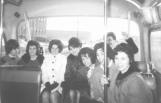 Credits:
Credits:Mary Jane Peden
Fort McMurray Historical Society
36
The Impact of St. John's Roman Catholic SchoolDespite a rocky start and on-going staff and resource shortages, St. John's Roman Catholic School provided a key element to the community's makeup: education. During the St. John's Separate School Board's first years, splitting the student population into smaller groups seemed financially unwise and threatened to bankrupt both the public and the separate schools. The dedication of regional bishops and the work of local citizens allowed the school to remain open and adequately funded. Fort McMurray's population expanded after the oil sands companies began to develop the area. When this happened, the presence of multiple schools and school boards became a blessing. As it was, the schools could hardly house the influx of students. The rapid construction of new schools in the 60s, 70s, and 80s indicates that dividing the population was no longer an issue.
The Catholic School Board also provided a different education than the public system. It offered grades eleven and twelve before the public school did. St. John's Catholic School also accepted transfers when the public board could not afford to run the upper grades. At least a few citizens switched into the Catholic system because they believed that St. John's School's quality of education was superior to the public system's. The public system, of course, was unable to call upon the Grey Nuns for assistance. These women taught in St. John's and the other Catholic schools virtually for free, and they worked hard both in and out of the classroom. These factors all contributed to providing a different--and some would argue better--education than the public system.
As far as the Mission was concerned, the primary reason for establishing the Catholic school board was to teach catechism and Catholic values. Unable to insist on Catholic education in the public school system, the clergy that pioneered this Board and others in northern Canada wanted to fulfill Article 26 of the Universal Declaration of Human Rights. This article guarantees parents' right to determine their child's education. Since its creation, the Catholic board has maintained the value of religious teaching and provided it to those who wished to be a member of their schools.
For more information about the Grey Nuns, read "Northerners Say: 'Thanks, Sisters,'" by Agnus Sutherland s.g.m, and published by Les Oeuvres de Mère d'Youville in 1996. See also "The Bishop Who Cared: A Legacy of Leadership," written and published by Agnus Sutherland s.g.m. in 1995. For more information about the Catholic Schools of Fort McMurray, see "Fort McMurray Catholic Schools Celebrate Their 50th Anniversary 1936-1986," written by Joan Jarvis and published by The Fort McMurray Catholic Board of Education in 1986, and "'Those Were The Days': Fort McMurray All School Reunion August 1, 2, 3, 1981," compiled by Mary-Jane Peden in 1981.
